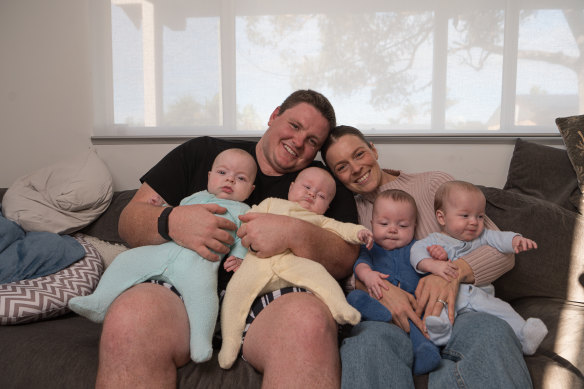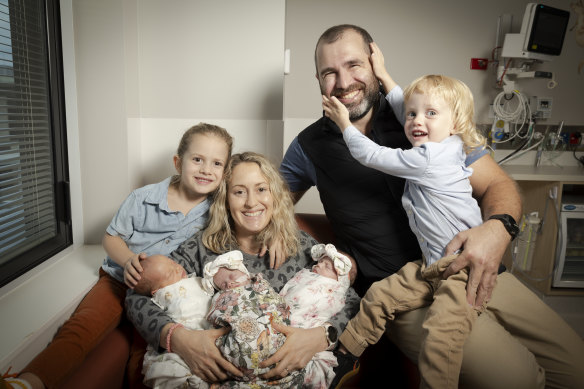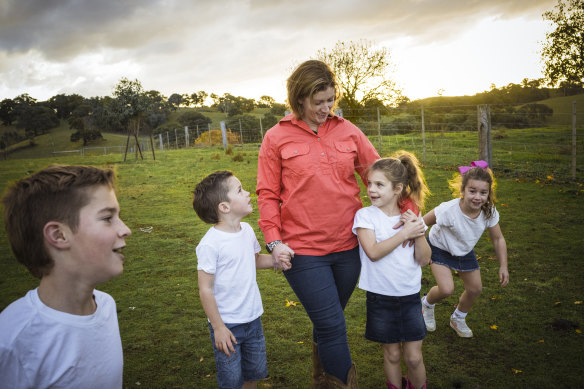By Mary Ward
Diagnosed with both polycystic ovarian syndrome and endometriosis, Taylah Tudehope-Glachan knew it may be difficult for her to conceive.
She and husband, Sean Glachan, tried for a year before turning to IVF. The couple, managing their expectations, were shocked to learn their first attempt had been successful. But the surprises kept coming. At their eight-week ultrasound, the sonographer counted the babies: there were four.
After setting up a dedicated account to document her miracle pregnancy, Tudehope-Glachan received a message from a stranger.

Sean Glachan, Taylah Tudehope-Glachan and their six-month-old quadruplets Archie, Billy, Charlie and Daisy at home at Buff Point on the NSW Central Coast.Credit: Flavio Brancaleone
Her name was Silje Andersen-Cooke, a mother of triplets from Canberra. She wanted to help.
“Every year there are approximately 4200 multiple births and each of those families requires extra support,” said Andersen-Cooke, the director of the Australian Multiple Births Association.
A volunteer-run organisation, which has operated in some form since the 1960s, the association provides advice, equipment hire and companionship for parents who find themselves welcoming two or more newborns into their family.
When they learn a local family is joining them in the chaos of having twins, triplets, quadruplets or – as has occurred just 11 times in Australia since 1967 – quintuplets, members mobilise to provide delivered meals, second-hand prams and playgroup invitations.
More Australian women are having multiple births now than 20 years ago, an increase attributed to more families conceiving using assistive reproductive technologies.
The rate of multiples rose from 1.7 per cent of mothers giving birth in 2001, to 3.1 per cent in 2011, according to the Australian Institute of Health and Welfare. However, the rate has since remained stable (at between 2 and 3 per cent).
The Australian Multiple Births Association operates dozens of local clubs across the country.
While the odd member is found by Andersen-Cooke on Instagram, families are typically referred to the clubs in pregnancy by their obstetrician or by a maternal child health nurse at their six-week check.
It was a couple of months after the Glachan quads were born that northern NSW couple Brooke and Max Holcroft were also contacted by Andersen-Cooke. They had learnt their family of four was going to become one of seven.
“This was our attempt at going for a girl,” Brooke laughed.
Welcoming triplets Lilliana, Primrose and Robert in May, the Holcrofts’ attempt worked twice over. But, particularly in the midst of a very different pregnancy from Brooke’s previous two, the prospect of having three newborns at once was daunting.
“It was a bit of a shock: we were like – we are going to need three of everything?” Max said.

Brooke and Max Holcroft’s family grew from four to seven, when Henry, 6, and Freddie, 2, were joined by triplets Robert, Primrose and Lilliana. Credit: Danielle Smith
Michelle Zugaro, from Reedy Creek, north of Melbourne, was in a similar position to the Holcrofts six years ago when she gave birth to twins Lily and Ryan after having two “singletons”, a term used by the multiple births community to describe single-child pregnancies.
Expecting to have figured it all out by her third child, instead Zugaro was facing an entirely new experience. After asking her obstetrician dozens of questions – “Do we feed both babies at the same time?” – he referred her to a local multiple birth club.
“I had found the newborn stage with one baby to be challenging, and I was really just wondering how anyone could do it with more than one,” she said.
Zugaro is now president of that club. She contacts new parents of multiples in the local area when they come home from hospital to take down their dietary details, then organises a meal delivery roster.
Once babies are a bit older, the club runs a playgroup (singleton siblings welcome).
Zugaro said the clubs were a lifeline for parents, particularly while on maternity leave.
“When you have more than one, you can’t just breastfeed in a cafe, so you end up staying home,” she said.

Michelle Zugaro is president of her local multiple births club. She’s pictured with her children Kevin, 10, Ryan and Lily, both 6, and Chelsea, 8.Credit: Chris Hopkins
Despite receiving referrals from maternity services, which are primarily the responsibility of state governments, the Australian Multiple Birth Association funds its operations entirely through membership fees and donations.
A submission prepared by the association ahead of this year’s federal budget asked for $2.875 million over three years to support its volunteers, develop an online education program and improve its relationships with health professionals and other referrers. However, the organisation did not receive any funding.
“Parents are reporting that they can no longer afford to pay a membership fee, and we are concerned that so many multiple birth families are missing out on connections with their peers and help from their community, especially in rural and regional areas,” Andersen-Cooke said.
Research commissioned by the association found Australia offers the smallest financial support to parents of multiples of any OECD country.
While Australia does provide parents of triplets and quadruplets on Family Tax Benefit with additional payments, other countries offer additional parental leave entitlements for families welcoming two or more newborns.
Jade McGrath, from Campbelltown in south-west Sydney, operates a library of equipment for parents of multiples. Items for loan include feeding pillows to support two babies, twin baby carriers and twin strollers.
She volunteers with her local multiple birth club because of the support it provided when she had her twins last year.
“We were in hospital for seven weeks – I only got 14 weeks paid maternity leave, so I used up half of that in hospital,” she said.
“There are so many things that were different from my other friends who had kids. The club gave me that extra bit of support.”
Andersen-Cooke said Australia was falling “far short” of adequately supporting parents of multiples, who are more likely to experience postnatal depression and also face higher expenses.
“We want to be able to support and provide a peer support community to every multiple birth family in Australia and to do that, we need support from the government,” she said.
Questions for federal Health Minister Mark Butler about support for multiple births were referred to the department who said in a statement: “The Australian government recognises the financial, emotional and physical challenges for parents and families associated with the birth of children and appreciates that these are often greater for families experiencing multiple births.”
Start the day with a summary of the day’s most important and interesting stories, analysis and insights. Sign up for our Morning Edition newsletter.